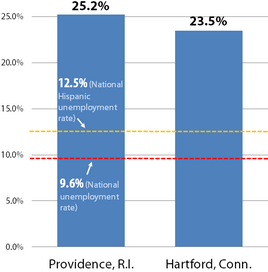EPI at 25:
Celebrating A Quarter Century of Success
Since the first publication of The State of Working America in 1988, EPI has compiled the only source of comprehensive data on the nation’s wealth, poverty, income, wages, inequality, and employment trends. Last year, EPI released the first online version of The State of Working America that includes easily searchable and accessible data, vivid interactive features, and ongoing analysis of the latest market numbers. With 11 previous print editions and its new electronic form, EPI’s State of Working America has been and remains an indispensible tool for academics, policymakers, activists, and the media to understand the economy’s effect on working Americans.
African Americans and Hispanics suffer disastrously high unemployment rates in metro areas
Two new EPI briefing papers by Algernon Austin, director of EPI’s program in race and ethnicity detail the catastrophic effect the nation’s jobs crisis has had on African American and Hispanic communities across the nation. In High black unemployment widespread across nation’s metropolitan areas, Austin compares the post-recession unemployment rates of 2010 to those before and at the end of the recession (2007 and 2009) in 31 metro areas.
At 24.7 percent, Detroit led the nation in black unemployment in 2010. Likewise, Milwaukee, Las Vegas, and Minneapolis all had black unemployment rates over 20 percent. Sun Belt cities were once a refuge for African Americans seeking employment before the recession, but the metropolitan areas of Charlotte, Miami, Tampa, and Las Vegas all had unemployment rates above the national black average and were among the highest rates of all the metro areas examined.
The Huffington Post used the paper’s findings to create this interactive slideshow depicting the 10 cities where black unemployment is rising fastest.
Hispanic unemployment rates in metropolitan areas around the country had similarly discouraging findings. Of the 38 places studied, 18 saw an increase in Hispanic unemployment of over one percentage point since 2009. Providence, Rhode Island had the highest unemployment for Hispanics with a rate of 25.2 percent, followed by Hartford, Connecticut at 23.5 percent.
This week’s Economic Snapshot further illustrates the high rates of Hispanic unemployment across the nation.

The metropolitan areas with the highest rates of Hispanic unemployment were much higher than the national Hispanic average of 12.5 percent and even rival the peak national unemployment rate during the Great Depression.
“Without a strong federal jobs program, the pain of very high unemployment is likely to be long-lasting for most of America’s metropolitan blacks and Hispanics,” said Austin.
EPI on the Hill
In addition to formulating sound economic policies that stimulate the economy and job growth, EPI has also been actively sharing these ideas with the nation’s leaders. On Tuesday, in a hearing before the House of Representatives’ Steering and Policy Committee convened by Minority Leader Nancy Pelosi, EPI President Lawrence Mishel explained the urgency of generating jobs and the positive impact that passing the American Jobs Act will have on the economy and small businesses.
“Increasing employment should be the nation’s top priority,” said Mishel. “And efforts like the American Jobs Act will produce the conditions for small and micro businesses to accelerate and sustain the economic growth that will propel this recovery forward.”
On Wednesday, EPI Research and Policy Director John Irons presented ideas on Capitol Hill that EPI first introduced in the budget blueprint Investing in America’s economy, a plan that prioritizes recovery while also stabilizing the nation’s debt. Hosted by Senator Kent Conrad (Senate Budget Committee Chairman) and Senator Jeff Sessions, the event offered the opportunity for Senate staff members to hear the responsible and progressive initiatives EPI encourages.
EPI in the News
In the past week, EPI’s experts have been cited in over 1,200 television, radio, and print media outlets. Some of the highlights include:
EPI Director of Trade and Manufacturing Policy Research Robert Scott’s recent report on the growing U.S. trade deficit with China was covered by a number of media outlets including, CBS Business Network, The Christian Science Monitor, The Associated Press, The Fiscal Times, and Roll Call.
- From CBS Business Network: “That statistic [2.8 million jobs lost between 2001 and 2010], courtesy of the Economic Policy Institute, is alarming on a couple of fronts. First, and most obviously, the U.S. economy can’t recover unless people have work. Employees are consumers, so job-losses curb domestic spending, which hurts businesses and discourages hiring.”
EPI President Lawrence Mishel’s recent paper disproving the claim that fear of regulations kills jobs continues to stir conversation among the nation’s top economic writers, including the New York Times’ Paul Krugman, Mother Jones’ Kevin Drum, New York Magazine’s Jonathan Chait, and the New Republic’s Johnathan Cohn.
- From Mother Jones: “EPI’s Larry Mishel wrote a pretty definitive takedown…and among other things he notes that business investment — which ought to be highly sensitive to the regulatory climate — has recovered considerably better over the past two years than it did during the first two years of the Bush recovery.”
- And New York Magazine: “If economic paralysis has resulted from business fearing Obama’s taxes and regulation — a thesis debunked by Larry Mishel— then surely the Republican offensive would have brought prosperity.”
Also appearing in the media, EPI labor economist Heidi Shierholz discussed the long-term impact of holiday hiring on the nation’s persistent high unemployment rate with Stephanie Clifford of the New York Times.
Macroeconomist Josh Bivens told Reuters that the “only thing that is going to help the employment situation in the next two years is macroeconomic policy.”
